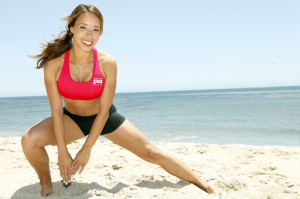Category Archives: Flexibility
Stop The Insanity
 “Every day we see more extreme “fitness programs” advertised with high-intensity workouts and volumes of work that even my elite athletes would never hold up to. And every day, we see the injuries in the clinic that define these workouts as ill-designed, dangerous, and unsustainable. What most recreational athletes and fitness buffs don’t realize is that elite athletes spend more than half of their time in the gym on injury prevention, and the rest of the time on performance enhancement. Safe and effective stretching and injury prevention workouts might not be spectacular to watch, but they allow athletes to work harder at their sport and in the gym on performance enhancement.” Robert Forster – Physical Therapist to 42 Olympic Medalists, NBA and Grand Slam Champions and Member of the Governor’s Council on Physical Fitness.
“Every day we see more extreme “fitness programs” advertised with high-intensity workouts and volumes of work that even my elite athletes would never hold up to. And every day, we see the injuries in the clinic that define these workouts as ill-designed, dangerous, and unsustainable. What most recreational athletes and fitness buffs don’t realize is that elite athletes spend more than half of their time in the gym on injury prevention, and the rest of the time on performance enhancement. Safe and effective stretching and injury prevention workouts might not be spectacular to watch, but they allow athletes to work harder at their sport and in the gym on performance enhancement.” Robert Forster – Physical Therapist to 42 Olympic Medalists, NBA and Grand Slam Champions and Member of the Governor’s Council on Physical Fitness.
Everyone knows how to work hard — it’s those who work equally hard on stretching, recovery, and injury prevention who reach their highest genetic potential in sport and in health.
24 Fit Workout
The basic premise of all well designed exercise programs is the progressive overload principle. Fitness must be “pushed” from below, i.e. starting slow and progressing to harder workouts slowly. The periodisation model used by 24Fit builds your fitness up with a stair step series of methodical, progressive challenges and recoveries that strengthen your body and keep brain and brawn fresh.
There are 3 phases each of 8 weeks:
Phase 1 – Stability.
Phase 2 – Strength.
Phase 3 – Power.
Phase 1 is about establishing stability throughout every part of your body. Thats Spine and Pelvic Stabilization, Shoulder Stabilization and Total Body Integration. By the time you’ve completed Phase 1, you’ll not only have improved posture and joint health, but your body will also be properly prepared for the strength and power workouts to come in Phases 2 and 3.
Contrast that with some high intensive workouts creating a plethora of overuse and traumatic injuries and other ill designed training programs that not even Olympians would hold up under the stress of these workouts.
Get ready! Armed with a bulletproof fitness program and solid science based nutrition you’ll get great results..
Include Stretching Into Your Daily Routine
 Stretching only takes a moment, yet most of us don’t do it at all, and because we don’t, our bodies could be subject to unnecessary pain.
Stretching only takes a moment, yet most of us don’t do it at all, and because we don’t, our bodies could be subject to unnecessary pain.
“It comes to my attention that people spend more time on the health of their teeth than they do the rest of their body,” said physical therapist and develeoper of the 24 Fit Workout Robert Forster
Forster says we don’t even do the basics to keep our system running smoothly, namely simple stretching.
“The fascia, the tendons the ligaments, they by nature tighten over time. If you leave them unstretched, they will shorten,” Forster said.
And that shortening alters the position of joints at the bone, which causes poor posture, and that can lead to injury. Many of us sit for long periods of time, and that can result in tight hip joints, which can affect the spine.
Slouching at the computer or car causes the chest to tighten, head to jut forward and the upper back is thrown out of alignment, creating a host of hurt. But small stretch breaks throughout the day can really help.
Include stretching into your daily routine with the 24 Fit Workout. Thats clear instruction on a set of 13 DVDs backed up with Forster’s 30 years of experience.
Robert Forster developed the Herbalife24FIT program with Herbalife. He is one of the leading physical therapists for athletes, both recreational and elite. Over the course of his 30-year career, he has successfully trained Olympic gold medalists, U.S. Open and Wimbledon champions, NBA superstars and triathlon world-record holders. Tired of encountering ill-advised training programs that only cause more injury, Robert created a new approach to physical therapy, which is divided into phases that follow the body’s natural healing and growth patterns.
Why is stretching correctly important?
 Flexibility is one of the key factors of any good fitness routine. Yet, I believe many exercisers often misunderstand some key aspects related to correct stretching.
Flexibility is one of the key factors of any good fitness routine. Yet, I believe many exercisers often misunderstand some key aspects related to correct stretching.
How to stretch, when to stretch and how long to hold stretches are just a few of the questions that I hear on a regular basis. This week, I set out on a mission to work through the theories behind how, when and why correct stretching is important and I’ve summarized my findings below in the hope that we’ll all start prioritizing correct stretching technique as we work towards better fitness.
I’m the perfect candidate to test correct stretching philosophies because I’ve always had a love/hate relationship with flexibility. As an athlete, I would often get frustrated because I had to dedicate extra time to this slow and sometimes tedious and uncomfortable task. And, as a fitness enthusiast, I often find it frustrating that many classes do not allow enough time for correct stretching.
My hamstrings have always been tight and even as a child I couldn’t touch my toes without bending my knees. Some people are born to be more flexible than others: my sister was an amazing gymnast – she’s always been as flexible as can be – and I can see that each of my four children have different levels of innate flexibility. The good news is that whatever level of flexibility you’re born with, correct stretching will help you improve. I’ve stopped using the excuse that I’m naturally less flexible and now I can touch my toes with ease but, don’t be fooled, I’ve had to work up to it slowly and consistently.
Why is stretching correctly important?
1. Stretching helps you maximize your body’s ability to move freely.
In simple terms that means stretching helps you get out of your own way internally so your body can perform at its best. Tight soft tissue can restrict joint movements and hinder important tendons from effectively doing their job.
2. Stretching helps you avoid injury.
Training with tight muscles can lead to serious injury and muscle tears.
With these two reasons in mind, I never skimp on stretching before and after exercise.
How much stretching is enough?
This week I spent hours researching stretching and I’ve spoken with physical therapists, trainers, and coaches to find out what correct stretching really means for individuals. Everyone I spoke with and everything I read led me to this conclusion:
“Fitness is not a one size fits all situation and, because flexibility is a factor of fitness, you must determine what is right for your own body”
I recommend that you navigate your own personal stretching needs and keep my dos and don’ts in mind.
Correct stretching dos and don’ts
Do:
- Spend time doing dynamic stretches before exercising.
- Dynamic stretching involves gentle movements to increase your range of movement. It improves blood and oxygen flow to soft tissues prior to exertion and also prepares receptors within the muscle to perform.
- Prepare your body with fluid flowing movements such as arm circles, leg swings and gentle bending.
- Dedicate at least 10 minutes after a workout to loosen tight muscles with static stretches that you hold for approximately 30 seconds.
- Stretch to the point of slight discomfort then back off a little and hold. This type of stretching can improve your overall flexibility and may decrease the amount of muscle soreness you experience after exercising.
Don’t:
- Use jerky bouncing or forced movements to increase your range of motion as this can cause injury.
This ballistic stretching forces your muscles into an extended range of motion and the risks are not worth the rewards. - Stretch to the point of pain or severe discomfort. You shouldn’t ever hurt your body though exercise and too much flexibility is not good for your body.
- Your joints rely on muscle tension to hold them in the correct position so, if you overstretch or push your body past what is comfortable, you can increase the likelihood of joint and tendon problems.
Find your own perfect flexibility balance
There is an art to finding your body’s balance and the only way to do it is to be aware and conscious of your movements. It’s simple advice but make sure you exercise commonsense at all times when exercising! If you listen to your body the chances are that you will achieve results faster and you’ll avoid causing yourself injury. Part of this commonsense approach to exercising is listening to your body: if you feel any pain or discomfort then stop.
My final piece of advice is to show up a few minutes early to a class and do your own dynamic stretch routine before the class starts and if you need to, stay a little later after class to complete your warm-down. If you are rushed for time then don’t rush your stretching: try to make your main workout more effective instead by using combination exercises.
Your body is exactly that it’s ‘your body’. Take responsibility for caring for it correctly and never just copy someone else’s routine. Instead educate yourself and find what works for you. I recommend starting at the top of your body, gently working your way down and addressing all major muscle groups. Stretching and movement is natural, so relax and do what feels right.
Written by Samantha Clayton. Samantha is a paid consultant for Herbalife

